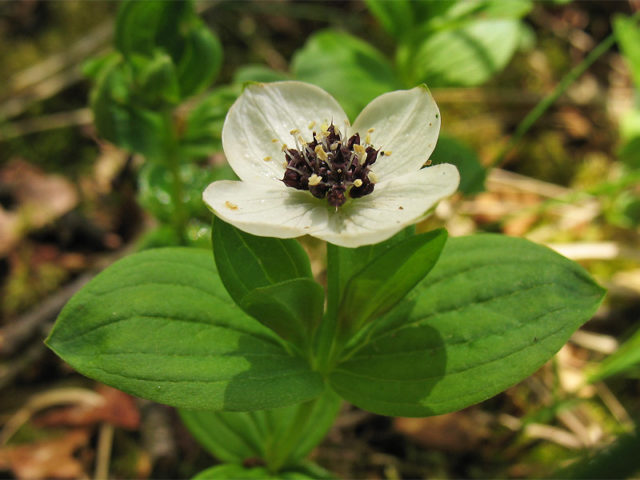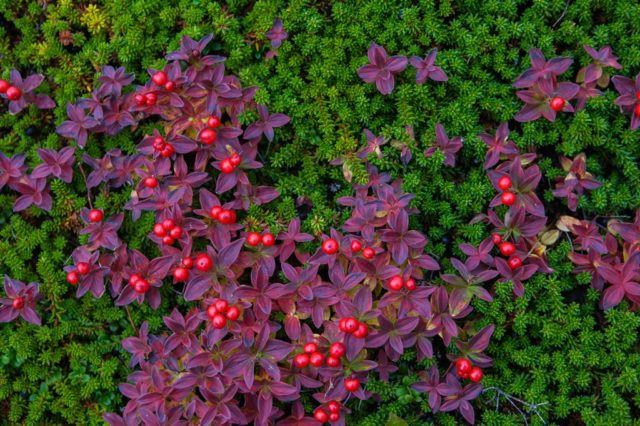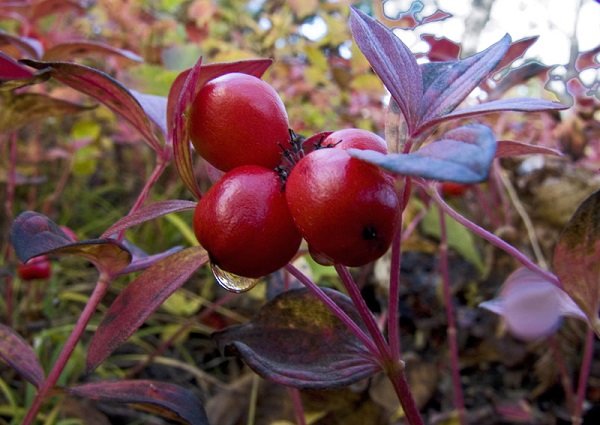Content
Cornus suecica - Swedish Derain grows on the coasts of the Barents and White Seas. You can meet him in the tundra and forest-tundra. In the North, in spruce and birch forests, the shrub forms small clumps or extensive thickets.
Derain is decorative in spring during flowering, in summer - during fruit ripening. In the fall, the shrub covers the ground with an elegant carpet. Its brightly colored leaves stand out against the background of rocks and green mosses.
Description of the Swedish deren
In nature, Swedish Derain grows next to lingonberries, blueberries, shiksha. This is a dwarf herbaceous dwarf shrub with a height of 10 to 30 cm. The plant is winter-hardy. It grows in regions with a stable snow cover. The root system is represented by a long, woody rhizome with many branching thin roots.
In spring, tetrahedral stems sparsely covered with hairs grow from their branches. With the onset of late autumn, they die off. Renewal buds are formed in the axils of the lower leaves. When spring comes, young shoots appear from them.
The deren leaves are very decorative. The lower ones are green, sessile, smooth with a bluish tinge on the back. The leaves located above are larger (15-45 mm), ovoid, pointed. On their sides 2-3 pairs of lateral veins are clearly visible.
The northern plant has very unusual flowers. The inflorescence consists of 8-25 small flowers. Narrow-triangular petals are black-violet, attached to short 2 mm pedicels.
The inflorescence is bordered by 4-6 white bracts. Bright framing is necessary in the tundra, it attracts pollinating insects. Derain Swedish blooms in May-June.
From July to September, fruits are formed on Derain, their characteristics:
- spherical or ovoid-spherical shape;
- diameter from 7 to 10 mm;
- color red;
- the bone is spherical, 3 to 3.5 mm in diameter.
Because of the large, hard seeds, the plant is popularly called "drupe". Outwardly, they vaguely resemble lingonberries. The northern ground cover plant adorns forests, woodlands, meadows of the Murmansk region. It can be found in the North-East regions of Germany, England, Finland, Japan. It grows in the Far East and North America.
Useful properties of Swedish deren
The plant Cornus suecica (Swedish dogwood) belongs to the dogwood family. The fruits of most members of this family have been used in traditional medicine. Employees of the Medical University from Arkhangelsk studied the chemical composition of the Swedish Deren fruit.
In the course of research, the following were isolated from the pulp of the fruit:
- tannins;
- flavonoids;
- minerals;
- glycosides.
The presence of these biologically active substances indicates the medicinal properties of the plant. In folk medicine, the fruits and the aerial part of the Canadian Derain are used. Even in ancient times, Eskimos used the fruit as an astringent, anti-inflammatory agent, and an analgesic decoction was prepared from the leaves.
The berries of the Swedish deren, ground into powder, help with nephritis, a decoction of the leaves - for fever. Eskimos and Canadian Indians ate the fruit.
Planting and leaving
In nature, Swedish Derain grows where the snow cover is thick. This must be taken into account when choosing a location. To grow an ornamental shrub in a garden, you need to prepare the soil. He loves wet, light, fertile soil with a slightly acidic reaction.
Derain grows worse on clay soil, the roots lack air.Sandy soil is also not suitable for plants - they lack moisture. The bushes of the Swedish deren grow slowly and try to crawl into the shade. To improve the structure and create more favorable conditions for growth, high-moor peat is added to the soil.
Shrubs can be planted in drained, marshy areas. They are not afraid of waterlogging. For gardens where the water table is close to the surface, this groundcover is a good solution.
The semi-shrub Derain Swedish grows naturally in the North, where daylight hours are long in summer. It is necessary to create similar conditions in the garden. Choose a site that is bright, but at noon, closed from direct sunlight. Pines and other tall conifers create a comfortable, rarefied partial shade.
Care consists in maintaining constant soil moisture, providing partial shade on hot, sunny days. In winter, you need to cover the area with snow. In the spring - add peat and humus. The plant is unpretentious, it is readily used in landscape design.
Planted in moist, peaty soil, the shrub grows rapidly to form a dense carpet. During flowering, it is covered with many snow-white flowers, in summer it pleases the eye with bright greens and orange fruits. In autumn, the leaves of Derain swedish turn purple, and the berries are bright scarlet. The semi-shrub is used in the decor of garden lawns.
Reproduction
It is difficult for a gardener who decides to decorate his garden with a decorative subshrub. Derain Swedish is propagated in several ways:
- seeds;
- root suckers;
- dividing the bush.
It takes a long time for seeds to germinate. They ripen in late August or September.
The seed of the Swedish Derain is cleaned from the pulp. In autumn, they are sown in a greenhouse or in open ground, buried by 3 cm.The surface of the ridge is sprinkled with sand.
For spring sowing, planting material is stratified within 3-4 months. Sawdust mixed with sphagnum moss is poured into the container. The mixture is moistened, the Swedish Derain seeds are placed in it. The container is hermetically sealed and placed in the lower compartment of the refrigerator.
Easier to propagate Derain Swedish root suckers (shoots). They are formed in large numbers from the adventitious buds located on the roots. When the plant is at rest, root suckers are dug up and transplanted, separating from the mother bush.
By vegetative methods (division, offspring), a stunted, frost-resistant dwarf shrub is propagated in the spring. You can buy a seedling of a northern plant in the nursery, via the Internet. Many gardeners add to their collection during their tourist trips to the White Sea.
Plants purchased in horticultural centers adapt much easier and live longer. They are usually sold in containers. You can also buy shiksha seedlings there. The healing berry from the tundra is ideally combined with Derain Swedish and other northern plants.
Diseases and pests
Representatives of the genus Cornus are susceptible to fungal diseases. The leaves and shoots of plants are affected by the infection.
Disease | Description | Causative agent |
Powdery mildew | White cobweb bloom on leaves | Phyllactinia guttata, Trichocladia tortilis |
Spotted light brown | Brown blurred spots on both sides of the sheet plate | Ramularia angustissima
|
Whitish spot | Brown spots with a brown border | Ascochyta cornicola |
Diseases worsen the appearance of plants, reduce their decorative effect. With a strong infection, the foliage on the half-shrub dies prematurely. Fungal spores overwinter in plant debris.
On the leaves of a ground cover plant, the following can settle:
- aphid;
- gall mite;
- spider mite;
- other leaf-eating insects.
Sick plants from the fungus are treated with fungicides.Pests are fought with the help of insecticides: Fitoverm, Iskra, Fufanon.
Conclusion
Derain Swedish will help create an exotic corner of undersized polar flora in the garden of a country house. Compositions of dwarf shrubs from willows, wild rosemary, juniper, wolf bast will look great against the background of a luxurious carpet from the Swedish deren.
You can watch the video how to use other types of deren on your personal plot:














